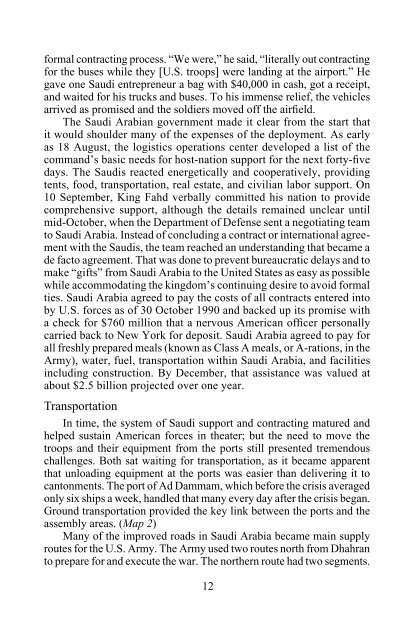Create successful ePaper yourself
Turn your PDF publications into a flip-book with our unique Google optimized e-Paper software.
formal contracting process. “We were,” he said, “literally out contractingfor the buses while they [U.S. troops] were landing at the airport.” Hegave one Saudi entrepreneur a bag with $40,000 in cash, got a receipt,and waited for his trucks and buses. To his immense relief, the vehiclesarrived as promised and the soldiers moved off the airfield.The Saudi Arabian government made it clear from the start thatit would shoulder many of the expenses of the deployment. As earlyas 18 August, the logistics operations center developed a list of thecommand’s basic needs for host-nation support for the next forty-fivedays. The Saudis reacted energetically and cooperatively, providingtents, food, transportation, real estate, and civilian labor support. On10 September, King Fahd verbally committed his nation to providecomprehensive support, although the details remained unclear untilmid-October, when the Department of Defense sent a negotiating teamto Saudi Arabia. Instead of concluding a contract or international agreementwith the Saudis, the team reached an understanding that became ade facto agreement. That was done to prevent bureaucratic delays and tomake “gifts” from Saudi Arabia to the United States as easy as possiblewhile accommodating the kingdom’s continuing desire to avoid formalties. Saudi Arabia agreed to pay the costs of all contracts entered intoby U.S. forces as of 30 October 1990 and backed up its promise witha check for $760 million that a nervous American officer personallycarried back to New York for deposit. Saudi Arabia agreed to pay forall freshly prepared meals (known as Class A meals, or A-rations, in theArmy), water, fuel, transportation within Saudi Arabia, and facilitiesincluding construction. By December, that assistance was valued atabout $2.5 billion projected over one year.TransportationIn time, the system of Saudi support and contracting matured andhelped sustain American forces in theater; but the need to move thetroops and their equipment from the ports still presented tremendouschallenges. Both sat waiting for transportation, as it became apparentthat unloading equipment at the ports was easier than delivering it tocantonments. The port of Ad Dammam, which before the crisis averagedonly six ships a week, handled that many every day after the crisis began.Ground transportation provided the key link between the ports and theassembly areas. (Map 2)Many of the improved roads in Saudi Arabia became main supplyroutes for the U.S. Army. The Army used two routes north from Dhahranto prepare for and execute the war. The northern route had two segments.12












